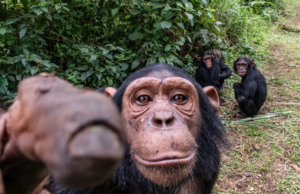PE ADVOCATE CRIES FOUL OVER SUPER BOWL SIMIANS
In the spot (titled "Grease Monkeys" despite the fact that its simian stars are not monkeys but apes), a slacker lounges in his garage as chimpanzee "mechanics" work on his car. Crowned with an oil filter, the man tells his neighbor that the chimps have made him their king.
The half-minute commercial may have generated a few laughs, and somehow even spiked motor oil sales, but the price paid by the animal actors isn\’t worth it, according to Patti Ragan, founder of the Center for Great Apes in Wauchula, Florida.
Ragan\’s facility is home to 42 chimpanzees and orangutans, many of whom are retired from show business. Some starred in previous Super Bowl commercials, including popular spots for E-Trade and CareerBuilder.com. It\’s because she is caring for these former Super Bowl stars that Ragan was troubled by the new Castrol spot.
"Having animals that have appeared in Super Bowl commercials before, and knowing what the issues are, it made me very sad to see those chimps, and to see that we haven\’t moved beyond that," Ragan said in a phone interview. "People don\’t think about what happens to these animals after they appear in these commercials. They don\’t know that we\’re sacrificing an endangered animal\’s future to make money for a company selling a product."
The use of apes in entertainment is nothing new (just ask Bonzo), but thanks to recent campaigns by Jane Goodall and other primatologists, we now know the problems inherent in the practice. On her website, Goodall points out that performing primates are separated from their mothers as infants and discarded by the time they reach puberty. Since chimpanzees live 50 to 60 years in captivity, that means these hirsute has-beens will require decades of costly care after the end of their short show-biz careers.
The lucky ones — like Jason Alexander\’s orangutan sidekick from Dunston Checks In — end up at places like the Center for Great Apes. The Castrol chimps may not be so fortunate. "I\’m beyond capacity," Ragan says, noting she has more than a dozen apes on her waiting list but lacks the resources to take them in. It costs approximately $15,000 a year to care for one ape, and like most non-profits, the Center is feeling the pinch of the current economic crisis.
While everyone involved with a commercial — from the network and ad agency to the actors, caterers, and animal trainers — makes money, nothing is put aside for the animals\’ future. No residual checks are wending their way to Wauchula for the former stars of the CareerBuilder ads, even though their likenesses are still being used on the company\’s website.
"CareerBuilder has stopped using chimpanzees in their commercials, which is wonderful, however they still have their Monk-E Mail campaign on their website," Ragan says. "They have our chimpanzee Bella, in a pink dress and pearls, and Ellie, a female that was seven-years-old, whom they put makeup on to make her look like an old male executive." (Bella is pictured above; Ellie is below left in the CareerBuilder ad, and right, at the Center.)
Ragan, who has urged the company to remove the chimps from its website, adds, "I would like CareerBuilder to consider the revenue they get from exploiting those chimps that we are now taking care of, and to think about where those chimps are right now."
Beyond their effect on the lives of the individual apes in the ads, commercials like Castrol\’s may have a negative impact on conservation, according to a recent study published in Science. The study found that because chimps are so widely used in TV shows and commercials, people assume they must be thriving — a dangerous misconception according to lead author Steve Ross, chair of the American Zoo and Aquarium Association\’s Chimpanzee Species Survival Plan. "This inaccurate and inappropriate portrayal of chimpanzees may negatively influence the way the public perceives this endangered species, which is in need of serious conservation efforts," Ross said.
Needless to say, dressing chimps in clothing and prompting them to mimic human behavior further distorts public perception of these apes. Such depictions may tickle the funny bone, but at what costω "For us to get a few yuks," Ragan says, "it doesn\’t justify jeopardizing the lives of these animals — taking them away from their mothers, using them for a few years, and leaving them with an uncertain future."
Some advertisers have chosen to get out of the ape business altogether. Honda, Subaru, and Yahoo! are among the companies that have pledged to quit using apes in their advertisements. Ragan applauds those companies and urges others to follow suit. She also calls on the advertisers, networks, and the Super Bowl itself to consider their complicity.
"The people who write these commercials and sell the companies on using great apes, and the people who buy these commercials and sell the airtime, they need to think about what they\’re doing to impact wildlife, impact animal welfare, impact people\’s attitudes about conservation, and impact these individual animals\’ lives."

 Español
Español
 Português
Português








